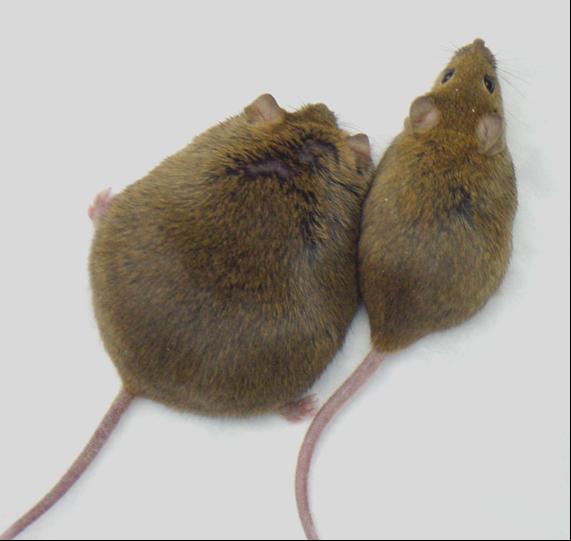Animal research in genetics
 One of the ways that animals are used in genetic research is through selective breeding experiments. This is when animals are bred with the goal of producing a specific phenotype.
One of the ways that animals are used in genetic research is through selective breeding experiments. This is when animals are bred with the goal of producing a specific phenotype.
Modern research using selective breeding often uses transgenic mice – that is, a mouse that has had a single gene changed or removed. In 2007 Mario Capecchi, Oliver Smithies, and Martin Evans won the Nobel Prize in Physiology for developing this procedure. These mice are also sometimes referred to as “knockout mice.”
Cases et al (1995) carried out a study on the genetic origins of aggression. For their study, they used a transgenic mouse where the gene that regulates the production of monoamine oxidase A (MAOA), an enzyme that breaks down serotonin and norepinephrine, was ‘knocked out” or deleted. High levels of serotonin and norepinephrine were found in the offspring of the transgenic mice. High levels of aggression were found in the male pups.
Does this animal model then help us to understand human behaviour? In a study carried out by Caspi et al (2002 ), the researchers carried out a 26-year longitudinal study of 1037 children born in Dunedin, New Zealand. The study included 442 boys. In their study, they looked at the genotype of the boys – particularly at the gene that controls the production of the MAOA enzyme – the same enzyme studied by Cases et al (1995).
The researchers wanted to see not only if the gene had an effect on the level of aggression in the children as they developed, but also whether environmental stressors may interact with the gene to determine behaviour. In other words, they were interested in the gene-environment interaction that is important to epigenetics.
By age 11, 36% of the children had been maltreated; this included rejection by the mother, physical and/or sexual abuse. The results of the study showed that if the abused boy had the version of the MAOA gene that resulted in low levels of enzyme production, they were more likely to bully others and engage in aggressive and antisocial behaviour. As adults, 85 percent of the severely maltreated children who also had the gene for low MAOA activity developed anti-social outcomes, such as violent criminal behaviour. Boys who were abused but did not have this gene did not show any more aggression than boys that were not abused.
It appears that this study confirms the findings in the animal model, thus bringing support to the theory of genetic influence in aggressive behaviour.
ATL: Thinking critically
Alzheimer’s disease affects about 50 million people worldwide. The disease causes a progressive loss of cells from the brain that impairs memory, emotion and reasoning. Eventually, the patient will die from the disease. As we continue to live longer, the number of cases of Alzheimer’s grows. This is a great cost to society – both economically and socially.
A recent headline read: New Alzheimer’s Treatment fully restores memory function
Australian researchers have come up with a non-invasive ultrasound technology that clears the brain of neurotoxic amyloid plaques - structures that are responsible for memory loss and a decline in cognitive function in Alzheimer’s patients. Of the mice that received the treatment, 75 percent got their memory function back.
The team says they’re planning on starting trials with higher animal models.
- A friend asks how they would have carried out their research. What do you think that they did in order to get these results?
- If you were in charge of funding this project, would you give the go-ahead to continue research on “higher animal models?” Why or why not?
The team says they’re planning on starting trials with higher animal models.
1. A friend asks how they would have carried out their research. What do you think that they did in order to get these results?
The researchers would do one of two things - first, they could introduce the proteins into the brains of healthy mice. More likely, the researcher may breed a certain type of rat that supports the genetic research for potential origins of Alzheimer's disease.
2. If you were in charge of funding this project, would you give the go-ahead to continue research on “higher animal models?” Why or why not?
This is a rather complex question. Students should recognize that there are problems with studying diseases like Alzheimer's disease in animal models. Alzheimer's is a complex disease. We can observe certain memory-related behaviours in rats - eg. spatial memory, being able to identify a "mate." However, being able to recall a specific word, or recognize one's family members is not highly relevant in rats. So, the research has to be based on what happens to the proteins in the brain. This makes the assumption that this is, in fact, the roots of the disease - and not only a symptom of the disease.
Animal research allows us to study the brain in a lot more detail than we could with human participants.
Unit revision: Checking for understanding
- What is one strength and one limitation of using animals in research in psychology?
- Explain how a case study could be done with animals.
- Describe the ethical considerations in Brady’s study of ulcers in “executive monkeys.”
- Why do researchers use transgenic mice? What advantage does that have in the study of behaviour?
What is one strength and one limitation of using animals in research in psychology?
There are several potential answers. For strengths - the ability to study several generations in a short period of time; the possibility of studying several animals from the same "family," the ability to carry out experimental research that would not be allowed in human participants.
The limitation is that there are still ethical concerns about the use of animals; animal behaviour may not be analogous to human behaviour; animals may have significant physiological differences to humans; we may misinterpret findings by overreading the nature of the behaviour (anthropomorphism) - e.g. the mouse appeared to be sad...
Explain how a case study could be done with animals.
Just like with humans, a longitudinal study of animals can be carried out which employs a series of observations or experiments.
Describe the ethical considerations in Brady’s study of ulcers in “executive monkeys.”
Remember that the concept of informed consent is not really relevant to animals as they cannot give consent. The most relevant ethical considerations in the study are "undue stress or harm" - especially because the researchers predicted that the animals would suffer from the stress in the experiment. They also are unable to withdraw from the study - but the modern rule is that they should be withdrawn when the researcher realizes that they are suffering. The problem with this study is that it was carried out before modern guidelines of animal research.
Why do researchers use transgenic mice? What advantage does that have in the study of behaviour?
Researchers use transgenic mice because the manipulation of genetic material allows for experimental research - allowing us to draw conclusions about the level of causality of a genetic mutation.
Potential exam questions
The HL extensions may only be asked as essay questions. Here are a few of the questions that you could be asked:
- Discuss the use of animal models in genetic research.
- To what extent does animal research provide insight into human behaviour?
- Discuss ethical considerations in animal research.

 IB Docs (2) Team
IB Docs (2) Team
